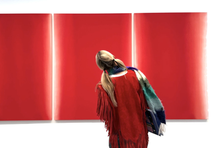Picasso and Paper at the RA: The paper seduced me
- The Courtauldian
- Mar 28, 2020
- 3 min read

Banner of the Picasso and Paper exhibition at the Royal Academy of Arts, London (25 January – 13 April 2020) (Image by Ellie Perry)
This is not the first large scale Picasso exhibition to come to London. 47 years after his death the artist remains one of the most loved and sought-after artists of the modern world. The amount of people attending the latest showcase of the infamous artist’s work also suggests it certainly won’t be the last. This year the Royal Academy has curated a huge show spanning the artist's career, from paper cut-outs at the age of seven to his final self-portrait at 90. This temporal range offers an ominous warning of the sheer length of the show. The Academy promises a ‘whirlwind of innovation.’ Yet, by the final room, my legs were tired, and everything looked the same. My fellow viewer’s review: ‘if you’re making exhibitions this fucking big, why wouldn’t you put more benches in?’--and she definitely has a point.

Installation view of the Picasso and Paper exhibition at the Royal Academy of Arts, London (25 January – 13 April 2020) (Photo by David Parry, the Royal Academy)
There is very little interaction between the display of the works and their architectural framework. Flat walls are superimposed to display series after series of sketches. This is especially striking in contrast to the previous exhibition held in the gallery by Anthony Gormley. Picasso’s drawings are obviously great. However, the curation was slightly unimaginative, and the amount of effort put into the gift shop, which includes a tiny café, seems to slightly outweigh that of the gallery itself.
The story goes that Picasso could draw before he could speak, and his first word was 'pencil'. This neat, yet somewhat, unbelievable tale is set out by the narrative of the exhibition. We are almost encouraged to compare his works as a child to that of an old man. A sense of playfulness and precociousness drives the exhibition onwards. However, despite the chronological approach offered by the RA, Picasso’s imagination is too lively to conform to a linear progression in style. The artist had a complex and varied relationship with the medium, even employing it to write poetry, describing it as a ‘palette of words.’ It is clear that Picasso valued paper as an artistic vehicle, one that early on in his career he could not always afford. The artist, like most, began by learning from copying the ancients, placing him perfectly within the tradition of the Academy. However, he swiftly moves away from this traditional practise seeking a ‘savage new language of artistic violence.’

LaVie, Pablo Picasso, 1903 (Image by Ellie Perry)
Picasso being Picasso, the artist did not just use paper to draw. He tore it and made three-dimensional sculptures with it. He xplored its multiple forms, from a blank white sheet to a crowded newspaper, to tobacco packaging. Despite the exhibition being based around paper, Picasso’s sketches are accompanied by a few paintings and sculptures throughout. Once again it is as if the artist’s imagination could not be limited to one medium, his ideas overfill and overflow across rooms in various shapes and sizes. However, his drawings are not simply preparations for these larger canvases, but unique creations in their own right.
So, if you like Picasso this exhibition provides detailed insight into his working practices. If like me, you just don’t mind him, beware the road is long with many a winding turn. If you have a few hours to carve out of a rainy afternoon, you might discover something mildly surprising about this slightly over exhibited artist. Or not.












Comments